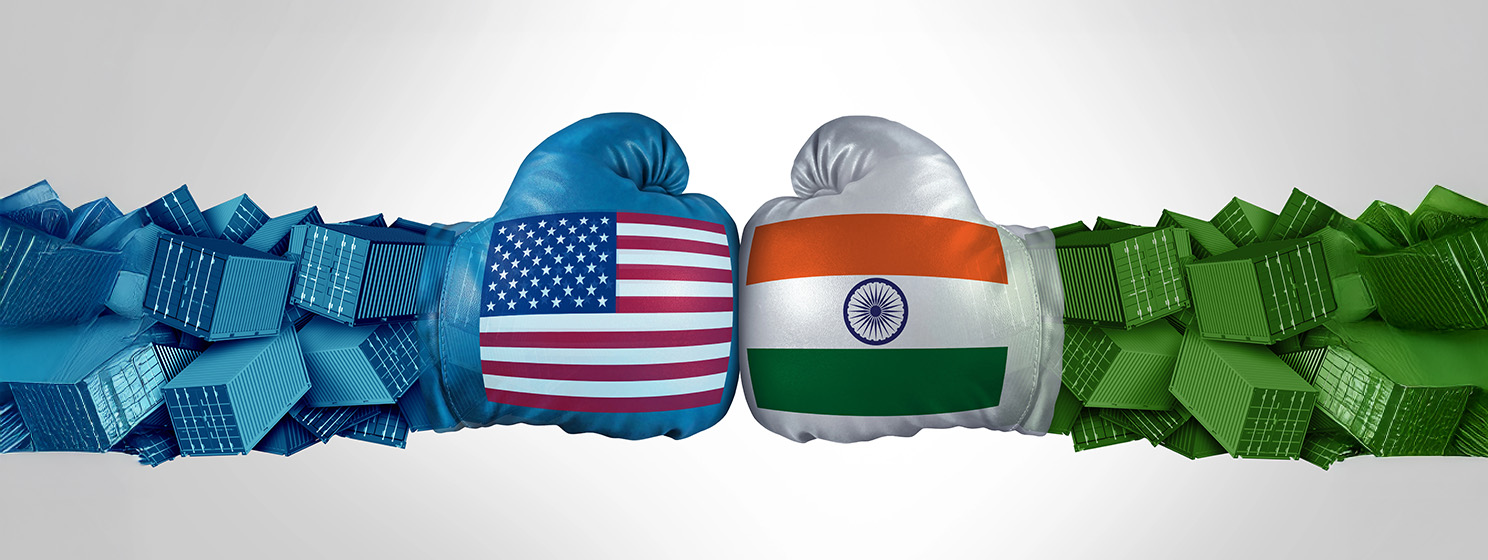|
Getting your Trinity Audio player ready...
|
In a sharp escalation of trade tensions, U.S. President Donald Trump has ordered a significant increase in tariffs on Indian goods, raising them to 50% in response to India’s continued purchase of Russian oil. This decision has triggered intense backlash from India and marks a deepening rift with a major Asian ally.
Trump signed an executive order on August 6, imposing an additional 25% tariff on Indian imports, on top of the 25% announced the previous week. The combined 50% duty—highest among Asian countries and at par with Brazil—is set to take effect from August 27, leaving a narrow window for potential negotiations to avert economic fallout.
In a separate announcement, Trump revealed plans to introduce a 100% tariff on semiconductors and computer chips, excluding only those manufactured domestically. This sweeping measure is expected to sharply increase the prices of electronics, vehicles, appliances, and other technology-based products, potentially disrupting global supply chains.
“The recent announcement by the U.S. to impose a [50%] tariff creates serious headwinds for India’s emerging technology sector, particularly in hardware and infrastructure. The increased cost of importing critical components is likely to slow the growth of hardware startups and data center expansion,” said Denys Peleshok, chief international growth officer at MD Finance, a technology company providing financial services.
“As global competition intensifies, Indian tech companies must diversify their markets, boost operational efficiency through automation, and strategically leverage AI [artificial intelligence] to maintain resilience and drive long-term value,” Peleshok told CoinGeek.
Sectors like artificial intelligence (AI), data centers, the Internet of Things (IoT), and semiconductor manufacturing—all heavily reliant on U.S.-made hardware and cloud services—could face rising costs and supply chain disruptions. Indian startups, particularly those dependent on American chipmakers or cloud platforms, may see reduced profit margins, delayed scaling plans, and a tightening of investor confidence.
More importantly, the tariff signals a deeper shift in U.S. policy: a turn toward protectionism that could erode the trust required for international technology collaboration. For India, a country whose digital economy depends on stable, cross-border partnerships, this kind of economic brinkmanship creates a dangerous level of unpredictability. Emerging sectors like Web3, already navigating murky domestic regulations, could face even greater uncertainty as U.S. venture capital hesitates in the face of geopolitical turbulence.
“With [50%] tariff on India, the parent companies may slow down spending considering tariff on services export and deteriorating India–U.S. trade relations,” Ritesh Verma, a mentor at Indian Institutes of Technology (IITs), told CoinGeek.
Clients may start worrying about possible future tariffs, which could raise the cost of IT development and maintenance, Verma pointed out. As a result, they might consider moving projects to other countries or spreading them across different locations to ensure business continuity and keep costs under control.
“For data centres, tariffs can indirectly effect and lead to cost elevation due to increase in material cost of building and maintaining data centres. This cost will eventually be passed on to users and affect the end-to-end supply chain, challenging the objective of cost effectiveness,” Verma added.
Tech startups need to rethink strategy, funding
Startups in the technology and Web3 sector will face both direct and indirect impacts. Those operating in sectors hit by tariffs will need to revisit their profit and loss, funding plans, and go-to-market strategies, Verma pointed out. Even startups not directly affected must evaluate potential indirect impacts, especially on current or future collaborations. The uncertainty around future tariffs makes it harder to create reliable business plans and adds a layer of risk to strategic decisions.
“For Web3 startups in India, the picture becomes even more precarious. Already facing regulatory uncertainty at home, they could now witness cooling investor sentiment from the U.S. VCs [venture capitalists] wary of geopolitical noise,” Raj Kapoor, founder of India Blockchain Alliance (IBA), told CoinGeek.
“The data centre ecosystem may also feel the tremors. U.S. cloud giants investing billions in Indian infrastructure may continue their bets, but with more risk filters and due diligence around policy stability. More broadly, innovation partnerships depend not just on declarations, but on operational trust—shared R&D (research and development), co-development, and open standards,” Kapoor added.
On February 13, Trump, recognized as the first president to openly support ‘cryptocurrency,’ welcomed Indian Prime Minister Narendra Modi to Washington, D.C., for an official working visit. During the meeting, both countries reaffirmed their ambition to increase bilateral trade to over $500 billion by 2030.
The leaders also announced plans to negotiate the first tranche of a mutually beneficial, multi-sector Bilateral Trade Agreement (BTA) by the fall of 2025. However, former Indian Finance Secretary Subhash Garg has cast serious doubt on the prospects of a U.S.-India trade agreement, citing deep and unresolved differences on critical issues. He emphasized that the chances of reaching any meaningful reconciliation are negligible.“I don’t think the situation is right at all to have a deal. You can keep the pretense of talking that will not lead anywhere. You have to weather this storm for the time being. Try to contain your damage. You can’t give in to all kinds of demands,” Garg told CNBC International.
Tariffs cloud future of US-India tech partnerships
In February, India and the U.S. launched the U.S.-India TRUST initiative (Transforming the Relationship Utilizing Strategic Technology) to strengthen cooperation among government agencies, academic institutions, and the private sector. This partnership aims to promote joint efforts in key emerging technologies, including artificial intelligence, semiconductors, quantum computing, biotechnology, defense, energy, and space. A key component of the initiative is a shared commitment to using trusted technology providers and safeguarding sensitive technologies, according to a joint announcement from both nations.
Under the TRUST initiative, President Trump and Prime Minister Modi committed to working with industry leaders from both nations to develop a joint roadmap for expanding AI infrastructure. According to their joint statement, this plan will address key obstacles, such as financing, construction, energy supply, and connectivity, for establishing large-scale AI systems built with U.S. technology in India. It will also lay out clear milestones and next steps. The partnership aims to encourage private sector investment in advanced data centers, improve access to AI computing resources and processors, and promote the development of AI tools and applications that tackle real-world challenges. Additionally, the initiative will emphasize creating safeguards and minimizing regulatory hurdles to support innovation and responsible growth.
However, initiatives, such as the U.S.-India TRUST partnership, depend not just on joint declarations but on policy stability, research funding, talent mobility, and mutual alignment. A tariff move shakes the very foundation of these collaborative efforts, raising concerns about visa policies, tech transfers, and export controls.
“The imposition of tariffs may not immediately derail strategic initiatives like the U.S.-India TRUST partnership, but it casts a shadow over their trajectory. TRUST, which includes cooperation on AI, quantum computing, and semiconductors, relies on a stable policy environment and mutual goodwill. A tariff move undercuts that foundation, prompting stakeholders on both sides to reassess the political will backing these ventures,” Kapoor of IBA told CoinGeek.
“The tariff threatens to undercut momentum built through bilateral initiatives like the U.S.-India iCET and TRUST programs, which were designed to foster deep collaboration in critical and emerging technologies,” Kapoor added.
The U.S.-India TRUST initiative, once hailed as a cornerstone of their expanding collaboration in cutting-edge technologies, now faces growing uncertainty as trade tensions escalate. The imposition of tariffs has introduced an element of instability that threatens to undermine the mutual confidence necessary for such high-stakes partnerships.
This shift in the geopolitical climate could have broader implications beyond diplomatic strain. With increased unpredictability in policy, American venture capital firms and infrastructure providers may hesitate to commit new investments in the Indian tech ecosystem. Rather than moving forward with funding and expansion plans, they may adopt a more cautious, wait-and-watch approach. As a result, India’s emerging role as a global innovation and technology hub could be called into question, potentially slowing momentum in strategic initiatives and delaying crucial financial and operational support.
“First and foremost, the TRUST initiative has become a symbol of deepening technological partnership, and now it is at risk due to tariffs. This could also lead to delays in funding or a review of India’s status as a regional hub. This could force U.S. venture capital funds and infrastructure providers to take a wait-and-see approach, leading to delays in funding cycles or a review of India’s status as a regional hub,” Peleshok pointed out.
Even a largely symbolic tariff dispute can inject significant uncertainty into the landscape of future investments and bilateral agreements, particularly in emerging technology sectors that depend on stability, long-term planning, and investor trust. These sectors, such as advanced technology and next-generation manufacturing, require not only substantial capital but also the assurance of a predictable policy environment. When trade tensions rise, it undermines that confidence, making it harder for stakeholders to commit to long-term projects. Potential investors may hold back, fearing abrupt policy shifts or retaliatory measures. As a result, vital funding streams could slow down or be redirected, stalling the growth of sectors that rely on sustained international collaboration and financial continuity.
“A tariff is a loud signal of divergence. Joint R&D labs, cross-border research funding, and talent mobility in critical sectors [such as AI and quantum tech] could hit friction points, especially in visa policies, export controls, and tech transfer limitations,” Kapoor of IBA added. “The question we must now consider is this: can countries truly collaborate on frontier technologies while playing tug-of-war over trade?”
Watch: India is going to be the frontrunner in digitalization

 01-06-2026
01-06-2026 




